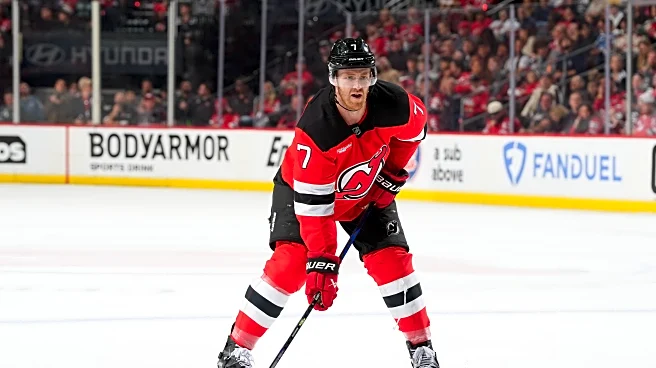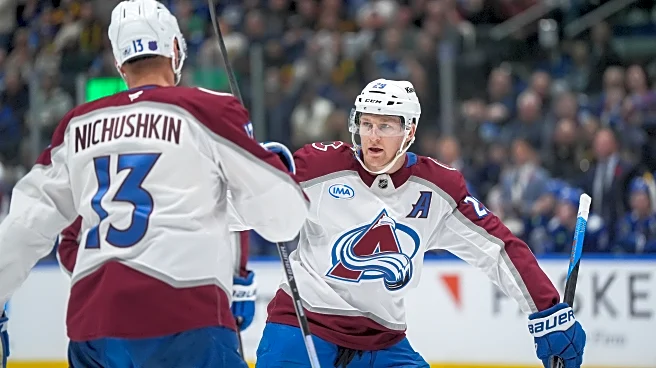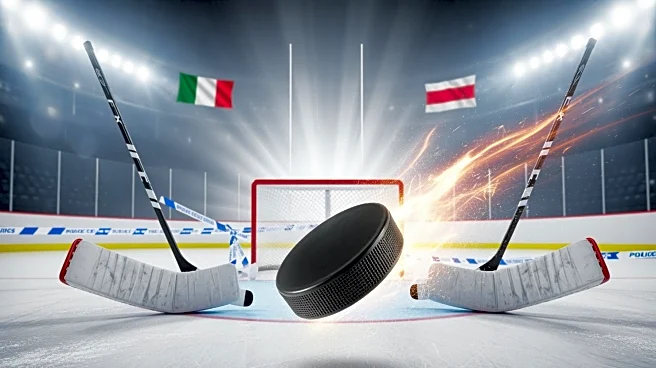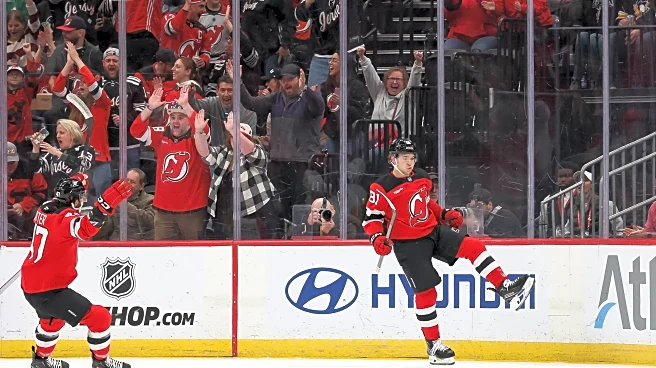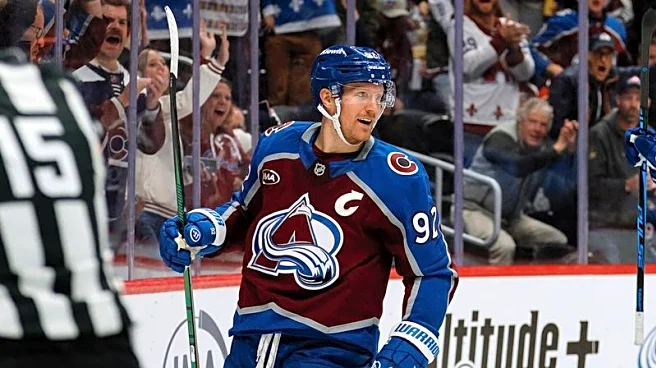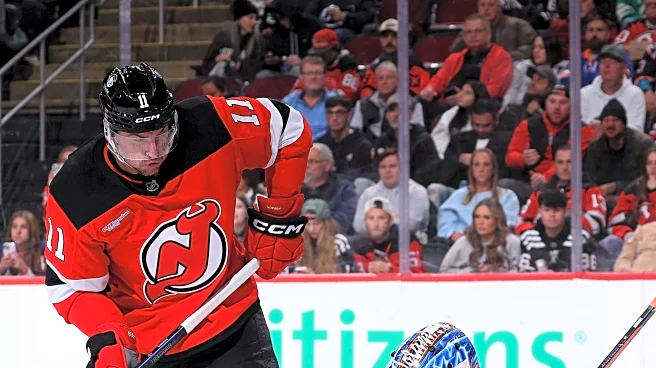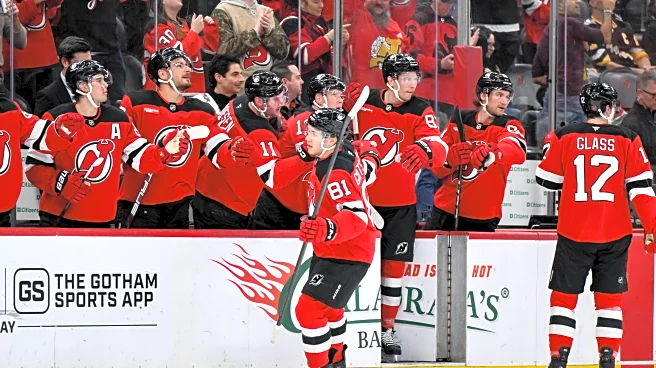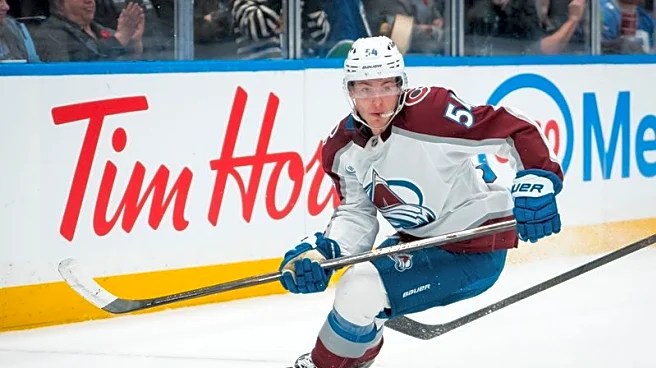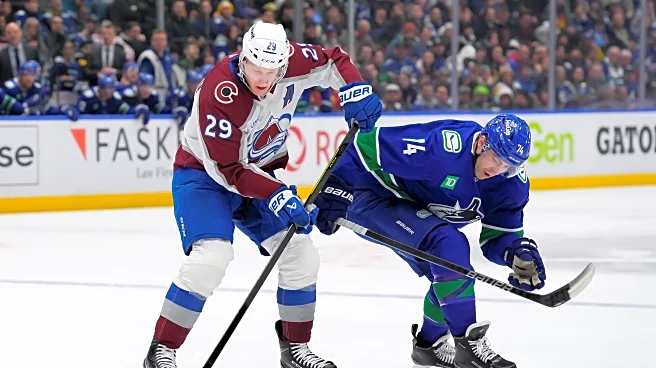There was one line from Elliotte Friedman’s most recent 32 Thoughts column that caught my attention this week.
“I don’t have an answer for this, but there is a lot of concern about all of the injuries. Maybe next year is different when the season starts earlier and the schedule isn’t so compressed. But everyone mentions the amount of injuries.“
This shouldn’t surprise you, a Devils fan reading this on a Devils-centric blog, one bit. We know all too well that the Devils have been ravaged by injuries
as much as anyone in the early portion of the season, seemingly losing somebody everytime they take the ice. With Dougie Hamilton going down with a lower body injury last week against the Montreal Canadiens, the Devils are essentially down their entire right side of the defense as Brett Pesce and Johnathan Kovacevic aren’t coming back anytime soon.
Evgenii Dadonov has been out since the season opener. Zack MacEwen just returned to the lineup this week after landing on LTIR after one game. Connor Brown has missed the last five games and counting. Cody Glass missed time. Stefan Noesen started late because of the groin injury he suffered last season. Jacob Markstrom missed a couple weeks.
That’s nine names I just rattled off there, which doesn’t include Seamus Casey or Marc McLaughlin starting the season on season-opening injured reserve. It also doesn’t include Shane LaChance or Lenni Hameenaho getting banged up in the Prospects Challenge and missing most of training camp. That’s a lot of injuries considering we’re not even a quarter of the way through the season at this point, and the fact the Devils are STILL among the teams with the best record in the league is a testament to the depth that Tom Fitzgerald assembled on this roster.
When it comes to injuries though, things aren’t much better across the league, as it seems like there’s star players going down everywhere you look. And there are a lot of notable names missing games who aren’t on that website I just linked. The Tkachuk brothers are out. Sasha Barkov is out. Mark Stone is on LTIR again, and as I write this late Tuesday night, I just saw that Auston Matthews and Anthony Stolarz both left the Maple Leafs game early only to not return. It doesn’t matter if you’re a grizzled veteran like Chris Tanev or an intriguing young player like Jake Neighbours. It doesn’t matter if you’re a behemoth of a man like Matt Rempe, a smaller player like Vincent Trocheck, or someone like Rickard Rakell who is somewhere in the middle when it comes to size.
There’s been a lot of injuries this year.
And here’s the thing with that…..it’s not good for the NHL.
Why Promoting Your Star Players Matters, and Why Keeping Them Healthy Matters
The NHL has done a better job the last few years of highlighting their star players and their personalities on and off the ice. Turn on any Devils game (or any NHL game in general) and you will have seen the “Work From Home” commercial featuring Jack Eichel, Mitch Marner, Sidney Crosby, and others. I’d link the video here if the NHL’s YouTube account hadn’t recently made said video private, but you surely have seen the ad, set to “9 to 5” by Dolly Parton.
I’m not saying these “The Next Golden Era Is Now” ads are reinventing the wheel when it comes to promoting players, nor am I saying casual sports fans are flocking to the NHL in droves because Jack Eichel and Mitch Marner are goofing off in an office setting in an ad. But there’s been enough of these ads the last few years where the NHL is finally starting to get what more successful sports leagues like the NFL and NBA figured out decades ago.
Star players do a lot of cool things in games. They’re fun to watch. In many cases, they’re easy to root for.
Promote them.
The problem with that though is how are you supposed to promote them when they can’t stay on the ice?
Remember a few years ago when Jack Hughes caught some heat in hockey circles when he chirped Viktor Arvidsson by saying “people pay to watch me play” after he felt Arvidsson was taking a run at him. Jack wasn’t too far returned from a lengthy absence due to a shoulder injury, and it would be understandable that he would be sensitive and protective of his health given the circumstances. I’m not saying Jack Hughes is necessarily thinking bigger picture when it comes to promoting the league when he’s in self preservation mode. But the thing about that incident that was true at the time and is still true today is that Jack Hughes is right. People do pay to watch him play. They don’t pay to watch the Viktor Arvidssons of the world take runs at people.
Devils fans, or really fans of any NHL team, will always go to watch their team play. But it would be naive to think that Jack Hughes, who is the Devils biggest star in terms of being a box office draw, hasn’t converted some fans who weren’t necessarily fans of the Devils before he was on the team. You don’t think that the guy that Steve Valiquette infamously deemed “Instagram Hockey” might owe some of that popularity to the 606,000 people or so who follow him on Instagram?
Like it or not, Jack Hughes is a draw. Casual fans know who he is and they want to see him to Jack Hughes things. They do indeed pay to see him play. He’s a big part of the reason why fans of the other 31 teams might want to go to a Devils game as opposed to, say, the Flames, who with all due respect do not have a star player on the same level as Hughes. Fans of other teams now circle the Devils on the calendar for when the Devils come to town as much as we might circle on our calendars when Vancouver comes to town to see Quinn Hughes. Or when Edmonton comes to town to see Connor McDavid. Or when Colorado comes to town to see Nathan MacKinnon or Cale Makar. They weren’t doing that in the mid 2010s when the Devils team lacked marketable star players.
It’s important to remember that not every fan who goes to games is a season ticket holder who is going to just about every game. Just like anything else in 2025, going to an NHL game can be an expensive night out for the family. Most people might only have enough disposable income to go to one game a year, and they pick and choose their spots depending upon a variety of factors, with the opponent and what star player is coming to their city being a part of that decision making process. This stuff matters in a league where how you do at the gate has a direct impact on hockey related revenues, which ultimately affects the salary cap, and by extension, the growth of the league.
Players like the Tkachuk brothers are draws, whether its in their respective markets or around the league. We know this because every fan wishes their team was the one that traded for Matthew Tkachuk when he was available a few years ago, and every fan wishes their team can be the one to pry Brady Tkachuk out of Ottawa. If they’re not the best American-born player currently in the league, Auston Matthews probably is. He is a draw as well, and at the end of the day, people pay to see them play too.
Except we can’t see them play because they’re out hurt. This is a problem.
The Solution Isn’t As Simple as “Fire Everyone”
Generally speaking, I think the natural inclination and response from fans is to look for someone to blame when things go poorly. And to be fair, there are instances where you can indeed blame somebody for an injury. When Matt Rempe elbows Jonas Siegenthaler in the head and then chirps afterwards, yes, Rempe deserves blame for giving Siegenthaler a concussion. He’s a hack who doesn’t belong in the NHL. When Nick Suzuki, Auston Watson, or Billy Sweezey cross-check Nico Hischier, its their fault if they injure him in the process. Especially if, in the case of Watson, its a completely unnecessary hit. Or if in the case of Sweezey, its a bunch of repeated cross checks from another hack who doesn’t belong in the NHL.
If your takeaway is “the training and conditioning staff is doing a terrible job and they need to go”, I think you’re wrong. I’d argue that not only do you have no clue what you’re talking about, but if teams reacted as haphazardly as fans do on social media, there would be 32 job listings for head trainers next week for each club. Nobody would be satisfied with the job their team is doing.
I’m not trying to carry water for the Devils medical staff. I’m old enough to remember when Taylor Hall was day-to-day for months only to undergo season ending knee surgery in 2019. I don’t think the Devils are the most forthcoming NHL organization when it comes to divulging injury information publicly, and I didn’t like Sheldon Keefe’s flippant response the other day when pressed about Dougie Hamilton’s injury and if it was a lower-body injury. Considering that Hamilton missed significant time last season with a lower-body injury, he’s missed time just about every year he’s been in New Jersey, and the fact that there was nothing apparent that stood out from rewatching the tape, its a fair question to ask.
That said, the Devils are as data-driven and analytics-driven as any other professional sports team. They have a whole legion of people on their staff who work directly with the players and know their bodies and what they’re dealing with. They’ve only continued to add to that list this past offseason specifically for this reason. Given the investments ownership has made with this team, on and off the ice, it would be in their best interests to figure out a way to keep their players healthy. The Devils aren’t unique with this either as other teams have made significant investments in this area.
At the end of the day though, having dozens of the best and brightest minds you can put on payroll isn’t going to prevent Jack Hughes from losing an edge and crashing full speed into the boards shoulder first. Just like how it won’t prevent Watson from throwing an unnecessary cross check on Hischier like he did several seasons ago. Or it won’t prevent Rempe from elbowing Siegenthaler in the head.
You can take all the proper precautions in the world to ensure peak performance and have the best plans in place for recovery, but there’s only so much one can do that is preventative. You could be the safest driver in the world and take every precaution, but if somebody T-bones you because they ran a red light, you’re probably going to get seriously hurt, if not killed. It just is what it is.
Hockey is a physical sport. It’s probably second only to football in terms of sheer physicality, and its a small miracle that players can even make it through a season unscathed.
These are regular season games that are being missed. We all know the stories about what the players play through in the playoffs to try to win a Stanley Cup. You can only imagine how bad things actually have to be if a player is not playing a playoff game. We learned after the Devils were eliminated by the Hurricanes last year just how significant the injuries to Luke Hughes, Johnathan Kovacevic, and Brenden Dillon actually were. But we can’t even get to that point if players are still beat up from postseason runs of year’s past. It’s not a surprise that so many players from Carey Price, to Shea Weber, to maybe Alex Pietrangelo, see their careers end in unceremonious fashion because their bodies simply can’t take it anymore.
So, What’s the Solution? Is There Even a Solution?
We know what the problem is. Unfortunately, like Friedman, I don’t know what the solution is. I’m not sure anybody does. People a lot smarter than you and me can’t seem to figure it out. I understand that I literally just wrote that adding more people to the Devils braintrust is only going to do some much. Perhaps the same could be said for some of the potential ideas or solutions that I can come up….even if they are the types of things that probably need to be collectively bargained. But I at least have a few thoughts on ways to potentially address this issue.
Expand NHL rosters to 26 players
Frankly, I think expanding NHL rosters is long overdue anyways. If I were NHL commissioner, one of my first acts would be to require teams to carry a third goaltender. It’s a very good idea that I’ve floated in the past, especially if you’re one of the many teams that doesn’t have a bonafide superstar between the pipes.
But let’s go back to the Columbus game for a tangible example. Jake Allen started the game but left after two periods due to cramps. Jacob Markstrom was supposed to have the night off, but was forced to come in and play the third period. Markstrom played well coming in cold off the bench, but he got injured when other players collided into him and he wound up missing a few weeks.
There’s no way to know whether or not the same thing happens if its Nico Daws in that spot instead of Markstrom. Daws is much younger, so maybe he “manages” the collision better where he isn’t injured. Or maybe its unavoidable regardless of who is in net. But if you’re carrying a third goaltender, the Devils could have given Markstrom, a player they just committed a fairly significant investment in for two more years and $6M AAV, the full night off. They could have made Daws the backup on that night, and Markstrom could’ve avoided missing a few weeks altogether.
NHL teams currently carry three extras, but I think something we’ve seen with the Devils being a cap team the last few years is they’re really just carrying 1 healthy extra player or so at any given time. Teams use those spots to scratch injured players, like what the Devils are doing with Dougie Hamilton at the moment, and they only put the player on IR or LTIR if its absolutely necessary. And when would it be absolutely necessary? When you don’t have any more healthy bodies in reserve to dress and you have to go to Utica or the waiver wire to find one.
By expanding the rosters though, one could have someone in reserve when needed. You also now have that option of potentially sitting a bottom six forward who is playing through something rather than risking making a pre-existing injury worse by continuing to play a player who might be physically compromised.
I want to be careful and say that while this sounds awfully close to “Load Management”, that’s not necessarily what I’m advocating for. I think the NBA’s “Load Management” has been terrible for a variety of reasons, is as fan-unfriendly as it gets, and is ruining that sport, and its all going on in a league with 1/20th of the physicality of the NHL. With that said though, the Devils staff knows what players are battling and grinding through it.
Hockey players are tough. They’re going to want to play if they’re physically able to do so. That is commendable. But sometimes, you do need to save the player from themselves. Giving the team an option to give a guy a rest isn’t necessarily the worst thing.
Expand The Schedule So It Isn’t As Condensed
I preface this by acknowledging that this is an Olympic year and the reason why the schedule is what it is has to do with that.
But strictly looking at the schedule from a Devils perspective, is there any reason why the Devils had to start two days later than the season-opening tripleheader? Is there any reason why the Devils had to have a stretch where they played eight games in thirteen days, with half of those coming on a long road trip? Is there a reason why we have to have so many back-t0-backs? Is there a logistical reason why we can’t start the entire process a week earlier and build more off days into the schedule to give the players a chance to recover?
I get that the Devils consistently having more back-to-backs than the average team is likely a trade off for the advantage they have having some of the best travel in the league. Most road trips for the Devils are relatively short flights with so many teams located somewhere near the I-95 corridor. But we’ve also seen plenty of back-to-backs over the years where the team on the back end of them doesn’t have their legs and the quality of the product isn’t nearly as good as it could be with a fresher team in that spot. A quick look at the Devils schedule shows some gaps of more than 2 days off in a row where they could’ve stuck a game in there instead of scheduling a back-to-back, say, immediately out of the Olympic break.
When I’m talking about expanding the schedule though, I’m not talking about expanding the schedule to 84 games, which is something that was collective bargained despite it being a terrible idea. I’m talking about expanding it over a longer period of time so they’re getting those 82 games in over a span of, say, 200 days instead of the 187 it currently is this season. I do think opening training camps earlier and ultimately starting the season in that final week of September instead of the second week of October could help. The fact that Elliotte Friedman alluded to the schedule itself being an issue tells me that that’s what people around the league are probably telling him when it comes to assigning blame for this issue.
Re-think the Protective Equipment Players Are Wearing
We’re getting into the area where there might be some pushback from players but its probably worth taking a look at the protective equipment players are wearing in the first place.
Is there enough padding when it comes to shoulder pads and chest protection? Would another half inch of padding help? Are there too many exposed areas of the body that are unprotected? Is there enough padding in the gloves? Should the gloves be another couple inches longer to protect the wrists? Or should players be wearing wrist guards to protect an area of the body that is easily exposed? Is there enough padding with the helmets to protect from concussions? Is it time to introduce guardian caps? Would any of this even make a difference?
Admittedly, I don’t know enough about hockey equipment and the technology surrounding it as to whether or not there is room for improvements there, and whether or not it would even make a difference. I also know that players have historically fought against mandating equipment changes, and I would expect some pushback even with this being in the name of player safety. Helmets were made mandatory for new players in 1979-80 with players having debuted before that grandfathered in. Neck guards to protect against being cut by a skate blade will be mandatory for new players in 2026-27 thanks in part to the push that Devils GM Tom Fitzgerald made for this issue. Players who debuted before than are grandfathered in to not have to wear them.
I would expect some pushback from some players who prefer lighter equipment in a game where speed kills. I’m not a player but I can understand if they feel extra equipment is weighing them down and making them slower. I think there’s also players who are content knowing what the risks are and accept the risks that come with playing.
I do think its worth asking the questions though and seeing if more can be done in this area.
Make The Officials Call Penalties For Unnecessary Physicality, and Have the Department of Player Safety Actually Care About Player Safety
We all know hockey is physical and a lot of injuries are ultimately unpreventable. And that’s fine. There is a reasonable level of risk that is accepted by the players when they step out on the ice.
Can we at least do something about the unnecessary physicality?
We’ve all watched hockey long enough to see enough post-whistle scraps, for lack of a better term, where someone throws a late punch or cross check or otherwise unnecessary cheap shot. Does there really need to be a conference whenever a goaltender makes a save that results in pushing and shoving in front of the crease during the stoppage in play?
Now, most players aren’t getting hurt in these scrums, and I get that. But we’ve also seen plenty of instances where a player DOES get hurt on a late hit. We’ve seen instances where a player goes 15-20 feet out of the way to deliver a hit. They may say they’re finishing their check, but we know they’re sending a message, or they’re responding to a hit they took exception to earlier in the game, or in the case of some players, they’re simply taking advantage of a player in a vulnerable position.
I’m not saying I don’t want physicality in hockey. Far from it. I like the physicality in hockey. I don’t think wanting better protections for vulnerable players has hurt, say, the NFL or college football in terms of popularity. The NFL has infractions in place for unnecessary roughness and rules designed to try to protect the quarterbacks, and while some might feel those go to far, the reality of the situation is that there’s not enough good quarterbacks in the NFL to go around. College football has rules against “targeting” and while it seems like that’s their version of “is this goaltender interference”, they’re at least making an effort to protect vulnerable players who can’t protect themselves.
I don’t necessarily think we need new rules. Penalties exist for charging (side note: when’s the last time “charging” was called in a game), boarding, elbowing, and roughing, among others. But I do think the current rules need to be better enforced, and I think the officials need to worry less about making sure the penalties are even for both sides and take it seriously when shenanigans are taking place. Err on the side of player safety and call more penalties if you have to so there’s actually a deterrent for committing an infraction.
This is where I’ll get on my soapbox in regards to the NHL’s Department of Player Safety and whether or not they actually care about player safety at all.
It doesn’t make sense to me that the NHL has a former enforcer in George Parros run that department, and I believe the league in general is too soft and too inconsistent when it comes to actually handing out discipline. Just take a look at their Twitter account and they’ve gotten the cookie cutter format down to a tee. All they have to do is change the names and infractions and click ‘send’.
As a player, you might have to toe the line a little bit if you’re someone with a history of dirty play like Tom Wilson, Ryan Hartman, or Matt Rempe, but for the most part, players will get a fine for the “maximum allowable under the CBA” on the lighter side, or a game or two suspension at most. There simply isn’t enough of a deterrent for players to not take liberties, and the only thing the DoPS is consistent with is their protection of the perpetrator instead of the victim.
I’m not saying that most injuries in the NHL are the result of dirty play. Most aren’t, and most of the ones I’ve cited in this article aren’t. But some are, and more often than not, the DoPS has a history of coming up soft when it comes to holding players accountable for their actions. More often than not, the punishment is simply a slap on the wrist.
Final Thoughts
There’s a lot of randomness and dumb luck when it comes to injuries in the NHL. But the sheer amount of injuries that we have already seen this season should be a cause for concern. We haven’t even reached Thanksgiving yet and there’s a bunch of teams missing a half dozen players or more.
I’m not sure what the cause of this is. I suspect there are a variety of mitigating factors, several of which I already pointed out. I also suspect that the NHL is a copycat league, Florida is the reigning and defending Stanley Cup champion, and they’ve made a name for themselves with their physical brand of hockey, so there might be more physicality than normal this time of year as teams try to emulate Florida in that respect. But at the end of the day, its ultimately not good for the league if star players can’t get on the ice. It’s not good for the individual teams that are relying on these players to stay healthy and play well. It’s a league-wide problem and there’s no easy solution to fix it.
Perhaps some of the ideas I came up with could make a little bit of a difference, but its tough to say. If a player gets hit the wrong way, or takes a puck to the wrong area of the body, does it matter if he got hurt in Game #14 with days off on both sides, or Game #62 on the second half of a back-to-back? And even if the officials do call the game with a stricter whistle, you can’t exactly put the toothpaste back in the tube if a guy delivers a dirty hit late. What’s done is done, the league will hand out their suspension, and they’ll wash their hands of the situation.
What I do know is that this ultimately makes for a worse product. And considering the league wants fans like you and me to pay to go to the games, pay for the streaming services to watch, and buy merchandise, there should be incentive on their side to find a solution to this issue.
